Search Result
Results for "
tumor imaging.
" in MedChemExpress (MCE) Product Catalog:
| Cat. No. |
Product Name |
Target |
Research Areas |
Chemical Structure |
-
- HY-W034551
-
|
|
Others
|
Others
|
|
DOTA-tri(t-butyl ester) can be used in the synthesis of generations 3 (G3) nanoglobular magnetic resonance imaging (MRI) contrast agents for MR angiography and tumor angiogenesis imaging .
|
-
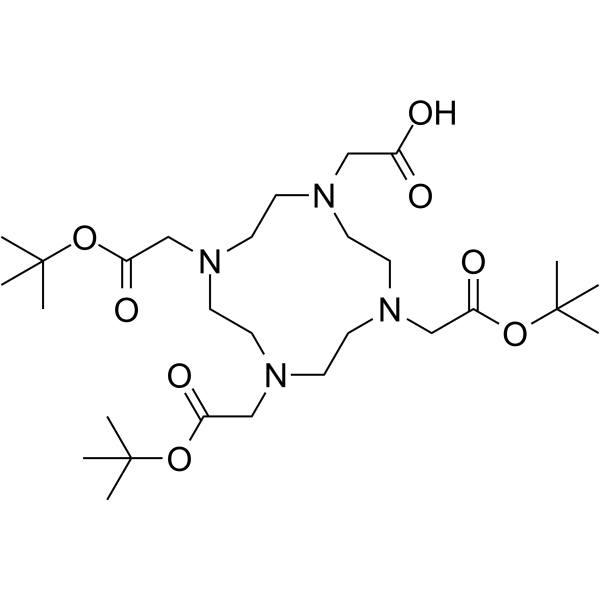
-
- HY-D2285
-
|
|
Fluorescent Dye
|
Cancer
|
|
MOR-CES2 is a near-infrared fluorescent probe (Ex= 630 nm, Em=735 nm) capable of identifying cancer cells and tissues, as well as exhibiting a sensitive response to inflammation. MOR-CES2 holds potential as an efficient imaging tool in assisting surgical resection of CES2-related tumors .
|
-

-
- HY-149298
-
|
|
PSMA
|
Cancer
|
|
PSMA-IN-2 is an inhibitor of PSMA with a Ki value of 1.07 nM. PSMA-IN-2 displays favorable in vivo NIR imaging (λEM = 1088 nm, λex = 808 nm), and can be used for NIRII image-guided tumor resection surgery in PSMA-positive tumor-bearing mice .
|
-

-
- HY-D1719
-
|
|
Fluorescent Dye
|
Others
|
|
Cypate, a cyanine dye, is a near infrared (NIR) fluorescent probe for in vivo tumor imaging .
|
-
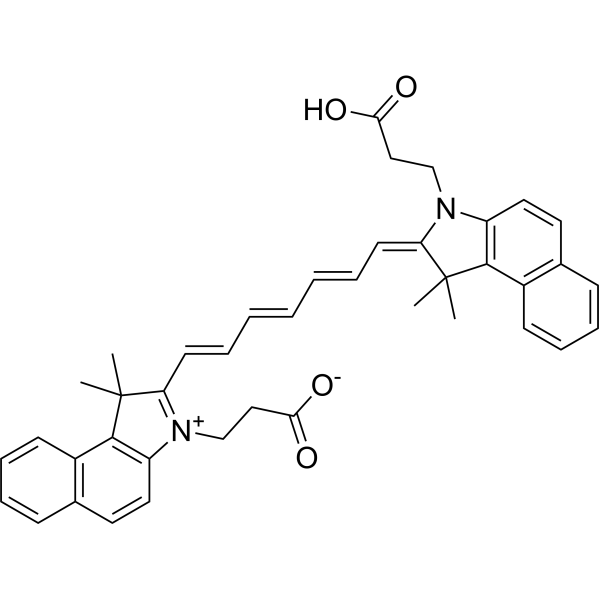
-
- HY-156982
-
|
|
Others
|
Cancer
|
|
Parpi is a PET radioactive tracer with low lipotropy. Parpi can be used as a tumor imaging agent .
|
-

-
- HY-136404
-
|
|
Others
|
Cancer
|
|
Melanin probe-1 is an 18F-picolinamides based PET probe. Melanin probe-1 can be used for PET imaging of malignant melanoma. Melanin probe-1 exhibits high tumor targeting efficiency, excellent tumor imaging contrasts, desirable biodistribution patterns, and good in vivo stability .
|
-
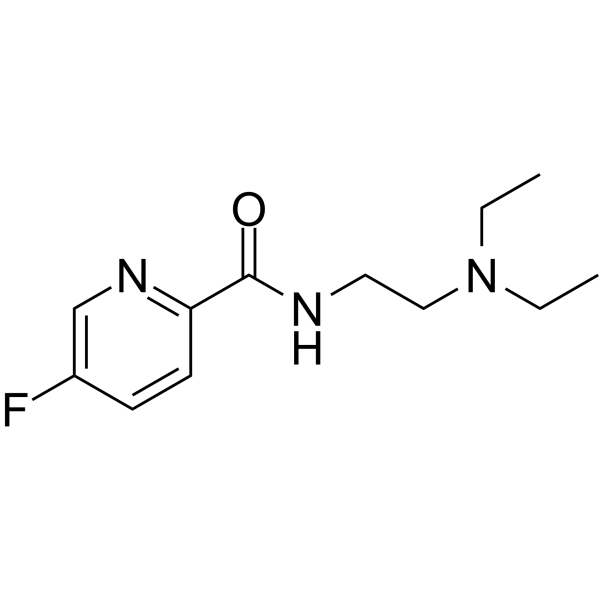
-
- HY-P1043A
-
|
|
Aminopeptidase
|
Cancer
|
|
NGR peptide Trifluoroacetatecontaining the Asn-Gly-Arg (NGR) motif. NGR peptide Trifluoroacetate binds to APN/CD13. NGR peptide Trifluoroacetate is directly conjugated to imaging agents that can be used for tumor imaging .
|
-
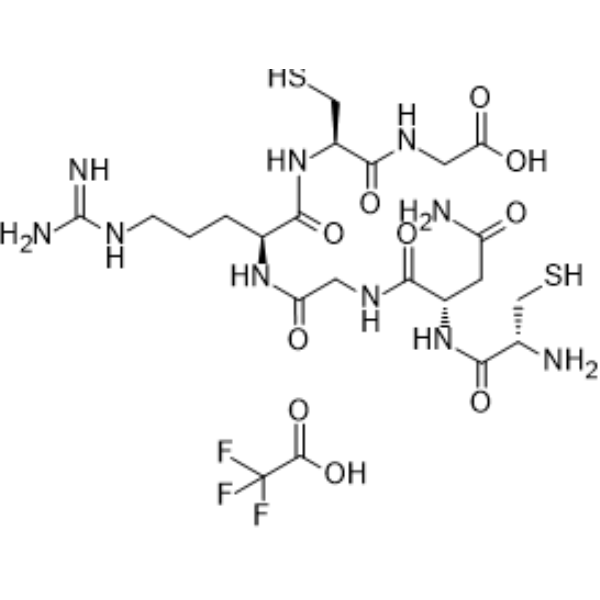
-
- HY-P1043
-
|
|
Aminopeptidase
|
Cancer
|
|
NGR peptide containing the Asn-Gly-Arg (NGR) motif. NGR peptide binds to APN/CD13. NGR peptide is directly conjugated to imaging agents that can be used for tumor imaging .
|
-
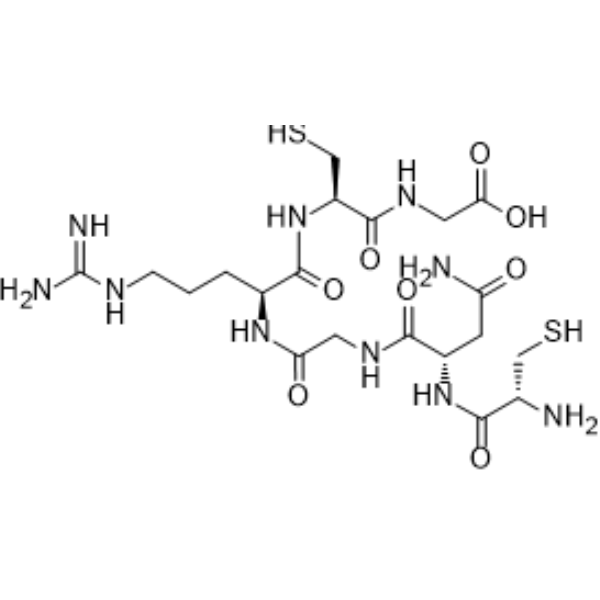
-
- HY-150979
-
|
|
Fluorescent Dye
|
Cancer
|
|
Gd-NMC-3 is a near-infrared fluorescence/magnetic resonance (NIRF/MR) bimodal imaging probe. Gd-NMC-3 shows high resolution and sensitivity in tumor imaging with good biocompatibility, indicating huge application potential .
|
-
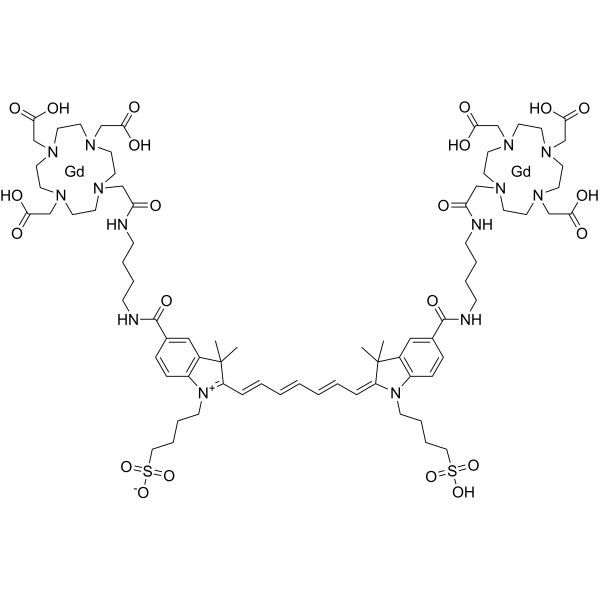
-
- HY-137331
-
FAPI-46
1 Publications Verification
|
FAP
|
Cancer
|
|
FAPI-46 is a quinoline-based fibroblast activation protein (FAP)-targeted radiotracer. FAPI-46 has higher tumor uptake and prolonged tumor accumulation. FAPI-46 can be used for tumor imaging of a multitude of different cancers .
|
-

-
- HY-47979A
-
|
|
FAP
|
Others
|
|
FAP-IN-2 TFA is a 99mTc-labeled isonitrile-containing FAP inhibitor derivative that can be used for tumor imaging .
|
-
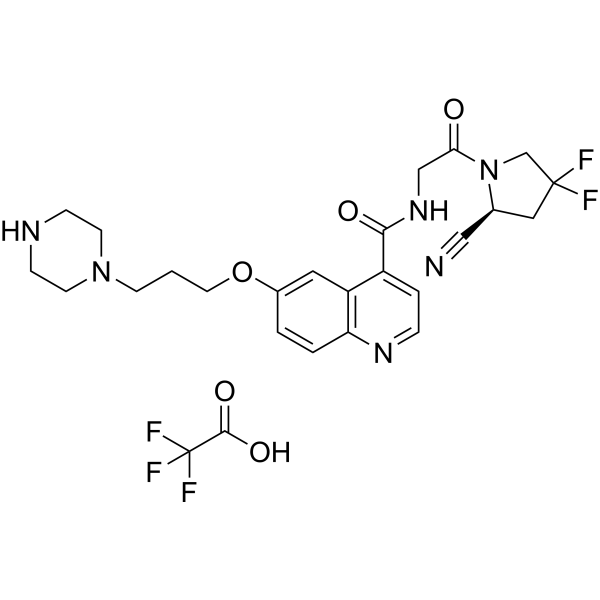
-
- HY-D1719A
-
|
|
Fluorescent Dye
|
Cancer
|
|
Cypate is a near-infrared fluorescent dye that belongs to the family of photosensitizers. Cypate has high photostability and optical properties, and is often used in near-infrared optical imaging, as well as optical imaging, tumor marking, and drug delivery. In addition, Cypate is also used as a molecular probe and combined with targeting molecules (such as CBT or small interfering RNA) to achieve efficient detection and imaging of specific cells or tissues .
|
-
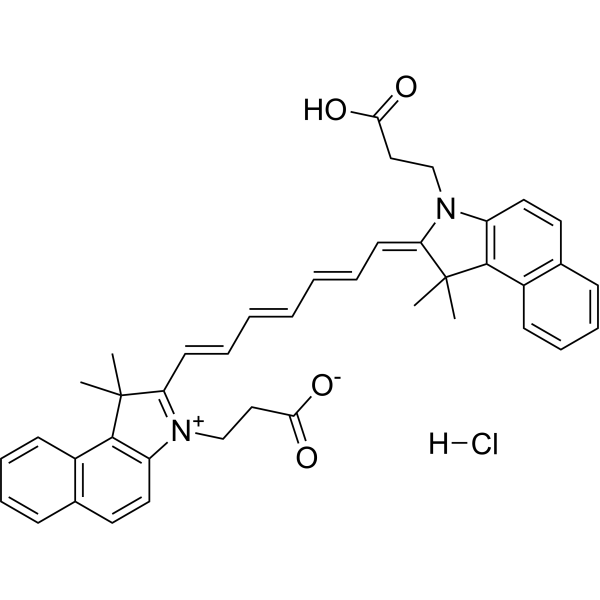
-
- HY-47979
-
|
|
FAP
|
Others
|
|
FAP-IN-2 is a derivative of 99mTc-labeled isonitrile-containing fibroblast activation protein (FAPI) inhibitor, that can be used for tumor imaging .
|
-

-
- HY-149931
-
|
|
Fluorescent Dye
|
Cancer
|
|
BMV109 is a quenched probe that becomes fluorescent when cleaved and covalently bound by active cathepsin proteases. BMV109 can be exploited for tumor imaging .
|
-
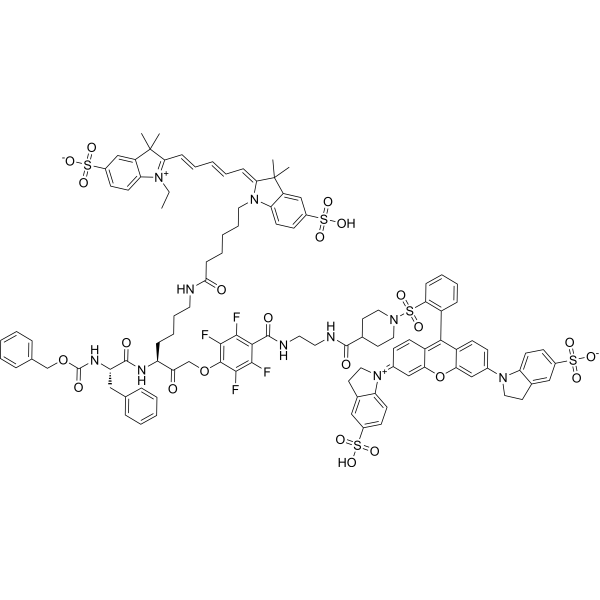
-
- HY-162051
-
|
|
Cytochrome P450
|
Cancer
|
|
CYP1B1-IN-6 (compound 19) is a fluorescence molecular probes which inhibits CYP1B1 activity. CYP1B1-IN-6 can identify tumor sites in fluorescence imaging and photoacoustic imaging modes .
|
-
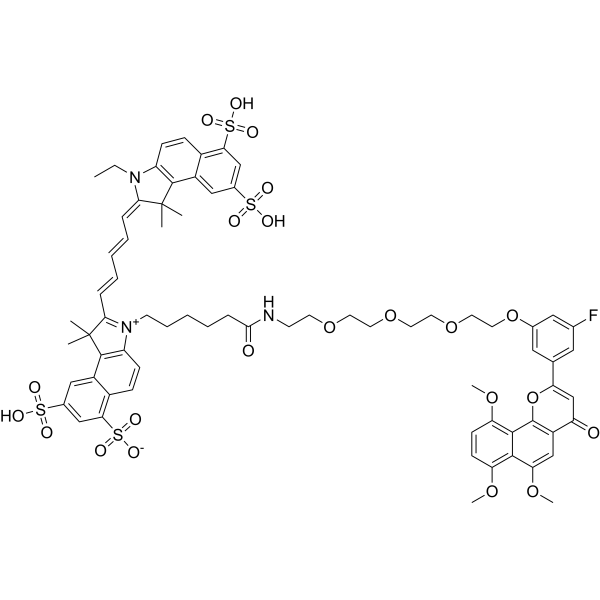
-
- HY-161074
-
|
|
FAP
|
Cancer
|
|
PNT6555 is a fibroblast activation protein-α (FAP) inhibitor. PNT6555 has antitumor activity. PNT6555 can be used for imaging of FAP-positive tumors .
|
-
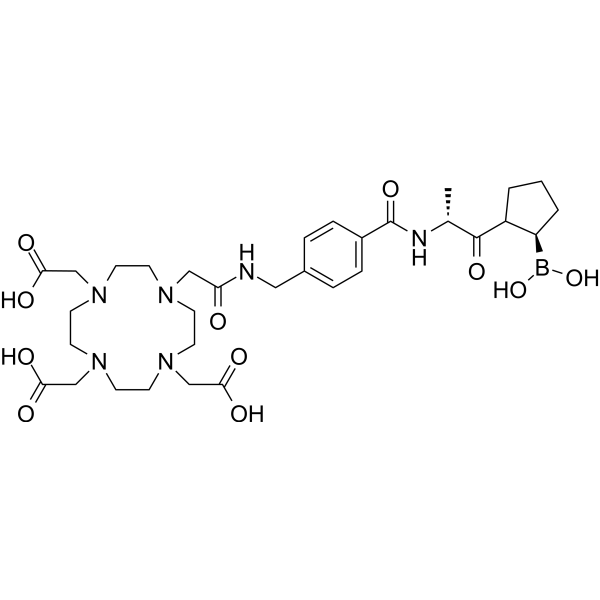
-
- HY-128890
-
|
|
ADC Linker
|
Cancer
|
|
DOTA-NHS-ester is a linker for affibody molecules and is applied in small animals PET, SPECT, and CT. DOTA-NHS-ester can be used to label radiotherapeutic agents or imaging probes for the detection of tumors .
|
-
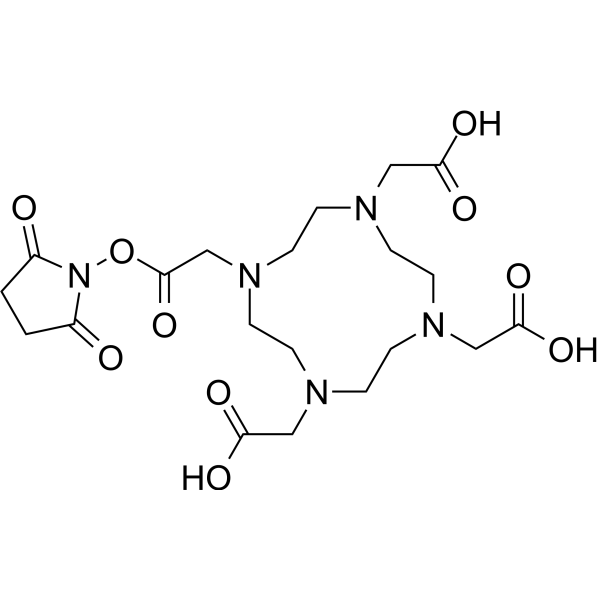
-
- HY-153432
-
|
|
Cholinesterase (ChE)
|
Neurological Disease
|
|
TRV-7019 is a BBB-penetrable radioligand for brain imaging that target butyrylcholinesterase. TRV-7019 can be used for the diagnosis of an amyloid disease, multiple sclerosis, a brain tumor, or butyrylcholinesterase activity .
|
-
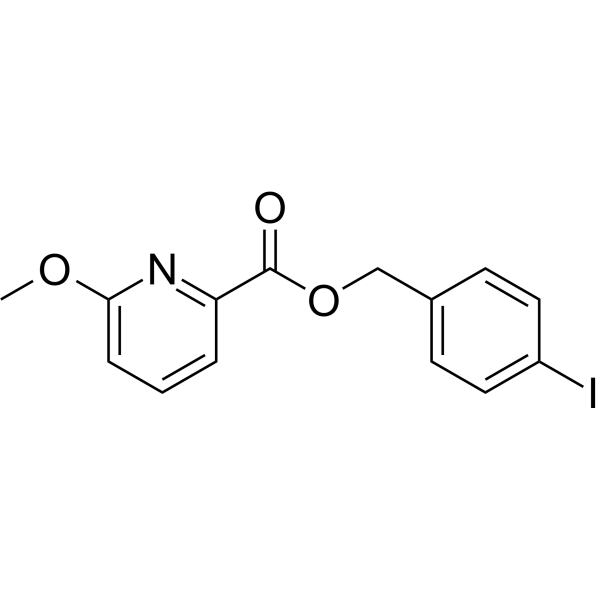
-
- HY-122607
-
|
|
Others
|
Inflammation/Immunology
Cancer
|
|
DPA-714 is a high affinity translocator protein (TSPO) ligand (Ki=7 nM), which is designed with a fluorine atom in its structure, allowing labelling with fluorine -18 and in vivo imaging using positron emission tomography. 18FDPA-714 successfully evaluates for the specific imaging of inflammation in various models of neuroinflammation and in a brain tumor model .
|
-
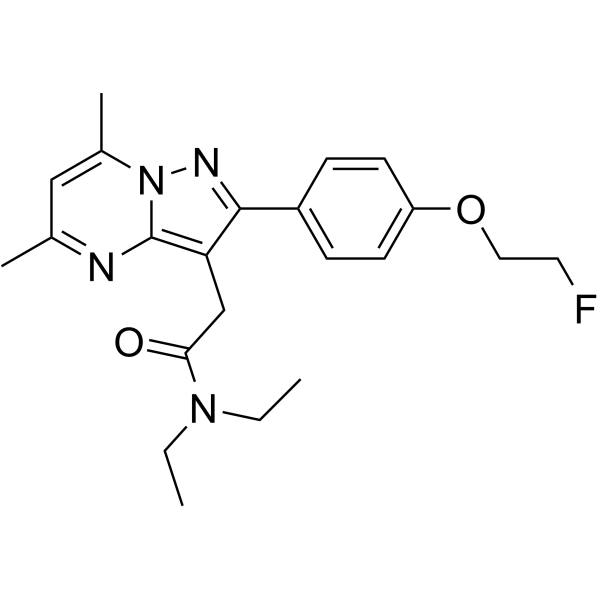
-
- HY-152102
-
|
|
Fluorescent Dye
|
Cancer
|
|
BTCy is a near-infrared (NIR) fluorescence probe with polarity-responsive and cell plasma membrane-targeting properties. BTCy can be used for in vivo imaging of tumor tissue (λex = 561 nm, λem = 600-700 nm) .
|
-
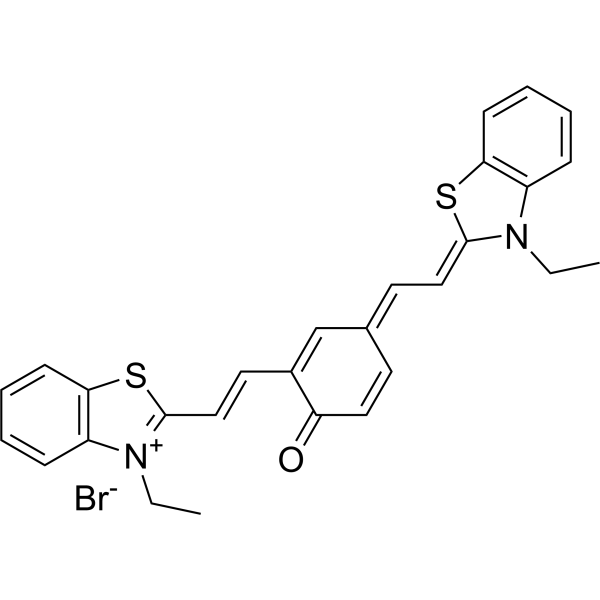
-
- HY-N7755
-
|
|
Estrogen Receptor/ERR
|
Cancer
|
|
Estradiol 3-(β-D-Glucuronide) sodium is the glucuronic acid derivative of estradiol (HY-B0141). Estradiol 3-(β-D-Glucuronide) sodium is radiolabeled for use in tumor imaging and biodistribution studies .
|
-
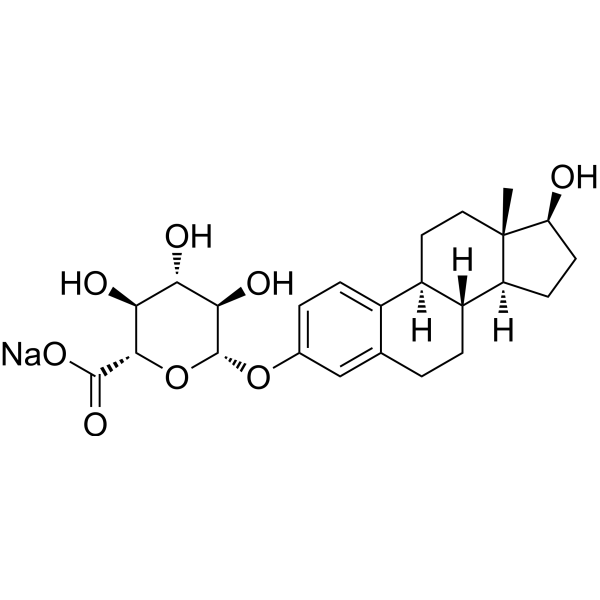
-
- HY-136201
-
|
|
Others
|
Cancer
|
|
Sodium Glucoheptonate is used as a kit for radio-labeling with Tc-99m. Tc-99m glucoheptonate is kidney- and brain-imaging agent, and can be used in brain-tumor detection .
|
-
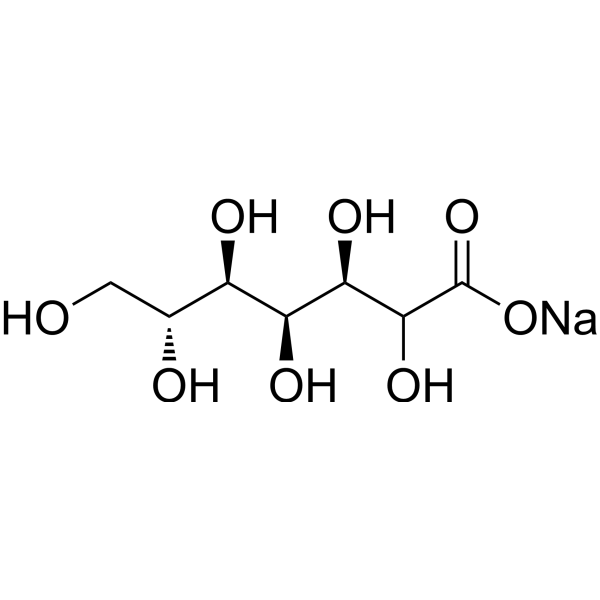
-
- HY-D2281
-
|
|
FAP
|
Cancer
|
|
[99m Tc]Tc-6-1, a 99mTc-labeled FAPI-46 derivative, is a specific fibroblast activation protein (FAP)-targeted radiotracer. [99m Tc]Tc-6-1 exhibits good tumor uptake and acts as a promising molecular tracer for FAP tumor imaging .
|
-
![[99mTc]Tc-6–1](//file.medchemexpress.com/product_pic/hy-d2281.gif)
-
- HY-P5128
-
|
Satoreotide tetraxetan
|
Somatostatin Receptor
|
Cancer
|
|
DOTA-JR11 is a somatostatin receptor 2 (SSTR2)antagonist. DOTA-JR11 can be labeled by 68Ga, used for paired imaging in neuroendocrine tumors (NETs) research .
|
-

-
- HY-D2334
-
|
|
HSP
|
Cancer
|
|
AlF-NOTA-c-d-VAP is a peptide positron emission tomography (PET) probe that used for targeted tumor imaging of GRP78. AlF-NOTA-c-d-VAP demonstrates high stability in vitro and in vivo .
|
-

-
- HY-147057
-
|
|
FAP
|
Cancer
|
|
FAP-2286 is a potent and selective FAP-binding peptide coupled to a radionuclide chelator with a mean IC50 value of 2.7 nM for binding to FAP. FAP-2286 can chelate radionuclides for imaging or therapeutic applications and has a strong effect on FAP-positive tumors. FAP-2286 can be used for FAP-positive tumor research .
|
-
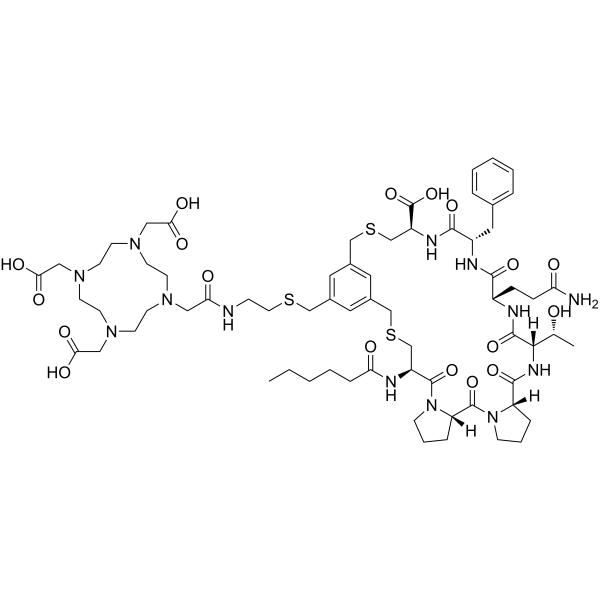
-
- HY-155485
-
|
|
Others
|
Cancer
|
|
Abi-DZ-1 is a potential multifunctional theranostic agent via the HIF1α/OATPs Pathway. Abi-DZ-1 can be used in the research of tumor-targeted imaging and precision therapy .
|
-

-
- HY-D1716
-
|
|
Fluorescent Dye
|
Cancer
|
|
S0456 is a near-infrared (NIR) fluorescent dye that can be used for synthesize Pafolacianine (HY-139579). S0456 binds to the folate receptor (FR). S0456 can be used as a tumor-specific optical imaging agent. The excitation wavelength is 788 nM and emission wavelength is 800 nM .
|
-

-
- HY-155486
-
|
|
Others
|
Cancer
|
|
HCy-AAN-Bio is a tumor-targeted hemicyanine (HCy) probe for Fluorescent/photoacoustic (FL/PA) imaging of legumain in vivo. Legumain can specifically cleave HCy-AAN-Bio with the generation of FL/PA signal. HCy-AAN-Bio is a powerful tool for early diagnosis of associated cancer .
|
-

-
- HY-17026E
-
|
dFdCTP trisodium
|
Endogenous Metabolite
|
Cancer
|
|
Gemcitabine triphosphate (trisodium) is one of the two nucleoside metabolites of Gemcitabine (HY-17026) in cells. The other is active diphosphate (dFdDTP). Gemcitabine triphosphate can be used as a standard in radio-labeled probe imaging studies, to identify tumors sensitive to Gemcitabine, and to evaluate Gemcitabine uptake and retention by cells .
|
-
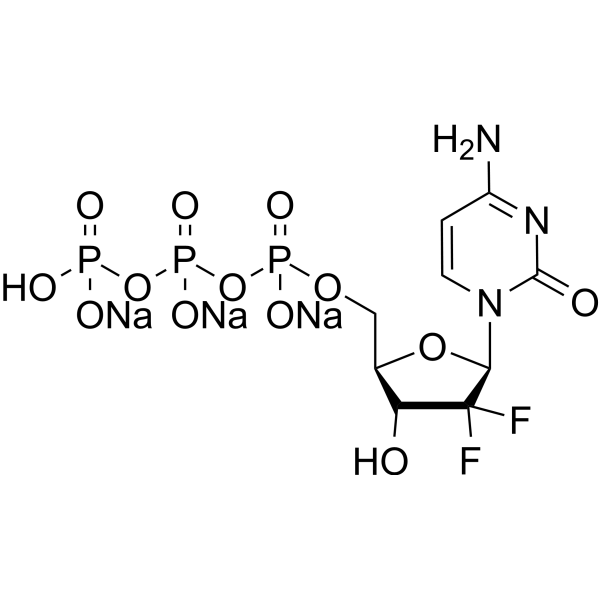
-
- HY-17026A
-
|
dFdCTP
|
Drug Metabolite
Endogenous Metabolite
|
Cancer
|
|
Gemcitabine triphosphate (dFdCTP) is one of the two nucleoside metabolites of Gemcitabine (HY-17026) in cells. The other is active diphosphate (dFdDTP). Gemcitabine triphosphate can be used as a standard in radio-labeled probe imaging studies, to identify tumors sensitive to Gemcitabine, and to evaluate Gemcitabine uptake and retention by cells .
|
-
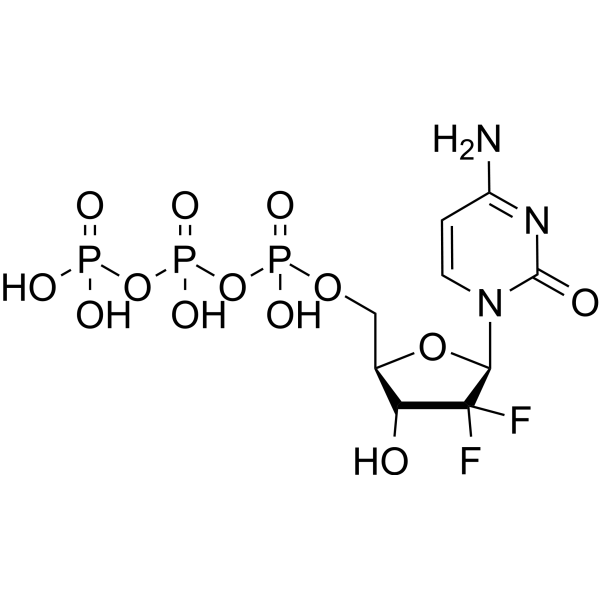
-
- HY-P5292
-
|
|
PSMA
|
Cancer
|
|
HYNIC-iPSMA is a ligand for molecular imaging of tumors. Hynic-ipsma consists of two components: HYNIC (6-hydrazinonicotinamide) and iPSMA (Inhibitor of Prostate-Specific Membrane Antigen). HYNIC is a compound used to attach radioactive isotopes to targeted molecules. iPSMA is a specific inhibitor used to inhibit prostate-specific membrane antigen (PSMA). 68GA-labeled iPSMA has been used to detect prostate cancer by PET imaging. The further 99mTc-EDDA/HYNIC-iPSMA has excellent specificity and sensitivity .
|
-
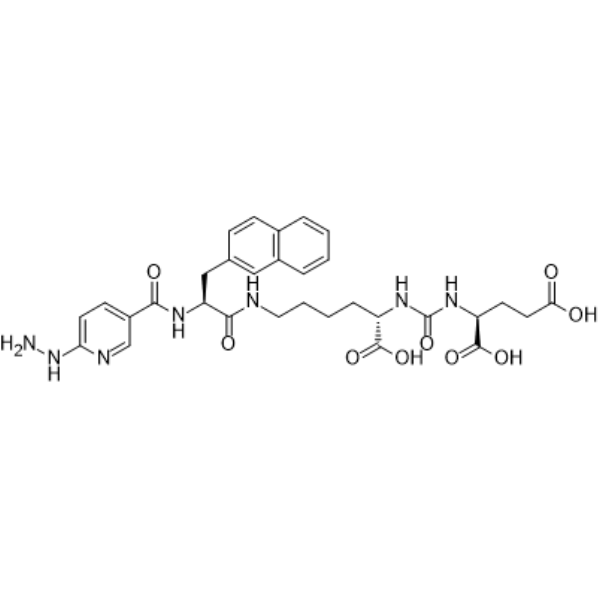
-
- HY-D1464
-
CH1055
1 Publications Verification
|
Fluorescent Dye
|
Cancer
|
|
CH1055 is a NIR-II fluorophore based on a synthetic 970-Da organic molecule. CH1055 is a rapidly excreted dye (∼90% excreted through the kidneys within 24 h). CH1055 also allows targeted molecular imaging of tumors in vivo when conjugated with anti-EGFR Affibody .
|
-
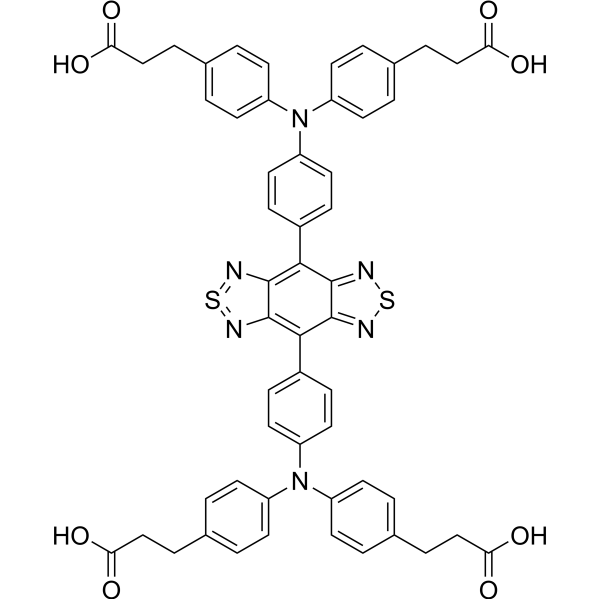
-
- HY-P99289
-
|
Antibody hLL 2; Anti-Human CD22 Recombinant Antibody
|
CD22
|
Inflammation/Immunology
Cancer
|
|
Epratuzumab (Antibody hLL 2) is an anti-CD22 IgG1 monoclonal antibody. Epratuzumab is also a tumor-imaging agent and an immunomodulatory agent. Epratuzumab can induce CD22 phosphorylation. Epratuzumab has been used to research non-Hodgkin’s lymphomas (NHL) and certain autoimmune diseases .
|
-

-
- HY-156124
-
|
|
Sigma Receptor
|
Cancer
|
|
Sigma-2 Radioligand 1 (compound 1) is a Sigma-2 selective ligand. Sigma-2 Radioligand 1 has good biodistribution in mice and good in vivo activity in rats. [18F] Modified Sigma-2 Radioligand 1 for visualization of tumors in micro-PET/CT imaging, exhibiting high tumor uptake and tumor-to-background ratio. Experiments show that Sigma-2 Radioligand 1 binds highly specifically in U87MG glioma xenografts .
|
-
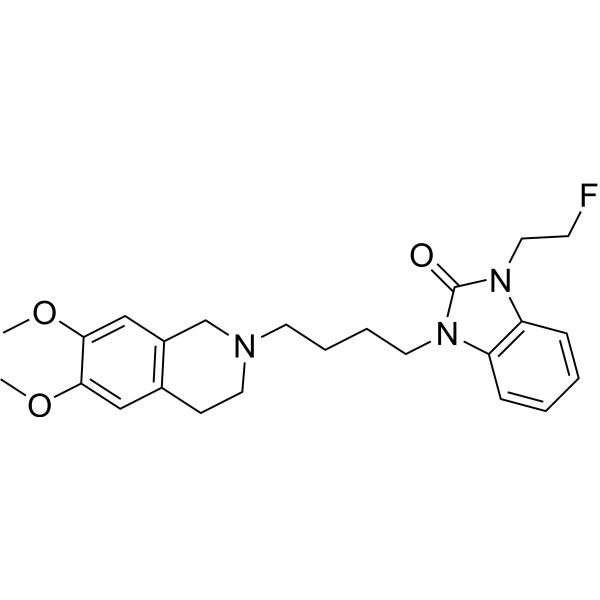
-
- HY-P5520
-
|
|
Bombesin Receptor
|
Cancer
|
|
GB-6 is a short linear peptide that targets the gastrin releasing peptide receptor (GRPR). GRPR is overexpressed in pancreatic cancer. Based on the tumor selectivity and tumor-specific accumulation properties of GB-6, GB-6 labeled with near infrared (NIR) fluorescent dyes or radionuclide netium-99m (99mTc) can be used as a high-contrast imaging probe. GB-6 has excellent in vivo stability, with tumor to pancreatic and intestinal fluorescence signal ratios of 5.2 and 6.3, respectively, in SW199 0 subcutaneous xenograft models. GB-6 can rapidly target tumors and accurately delineate tumor boundaries, which has broad application prospects .
|
-

-
- HY-128643
-
FAPI-4
Maximum Cited Publications
20 Publications Verification
|
FAP
|
Cancer
|
|
FAPI-4 is a potent fibroblast activation protein (FAP) inhibitor for the targeting FAP. FAPI-4 can be used in cancer research. 68Ga-FAPI-4 PET/CT is a promising new diagnostic method for imaging various kinds of cancer, with good tumor-to-background contrast ratios .
|
-

-
- HY-D1464A
-
|
|
Fluorescent Dye
|
Cancer
|
|
CH1055 triethylamine is a NIR-II fluorophore based on a synthetic 970-Da organic molecule. CH1055 triethylamine is a rapidly excreted dye (∼90% excreted through the kidneys within 24 h). CH1055 triethylamine also allows targeted molecular imaging of tumors in vivo when conjugated with anti-EGFR Affibody .
|
-
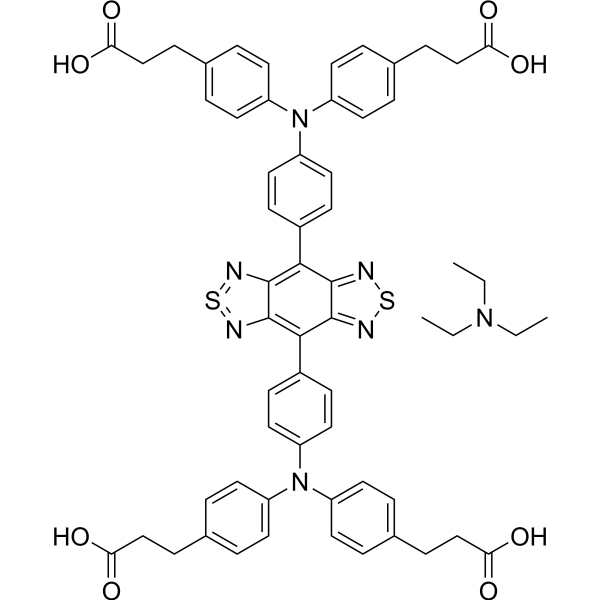
-
- HY-75706
-
|
|
E3 Ligase Ligand-Linker Conjugates
PARP
|
Cancer
|
|
N-Descyclopropanecarbaldehyde Olaparib is an analogue of Olaparib containing DOTA moiety. N-Descyclopropanecarbaldehyde Olaparib is a CRBN-based ligand for synthesizing novel dual EGFR and PARP PROTAC, DP-C-4 . N-Descyclopropanecarbaldehyde Olaparib can be radiolabeled F-18 or fluorophore for positron emission tomography (PET) or optical imaging in several types of tumor .
|
-

-
- HY-141464
-
|
Fmoc-Asn(Ac3AcNH-beta-Glc)-OH
|
Amino Acid Derivatives
|
Cancer
|
|
Fmoc-L-Asn(beta-D-GlcNAc(Ac)3)-OH (Fmoc-Asn(Ac3AcNH-beta-Glc)-OH) can be used in the synthesis of silicon-fluoride acceptor (SiFA) derivatized octreotate derivatives. SiFA-octreotate analogues, as tumor imaging agents, are useful tool for the research of positron emission tomography (PET) .
|
-
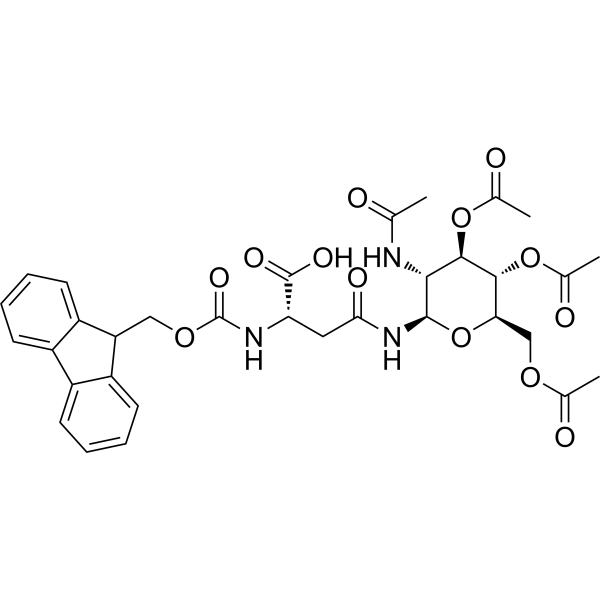
-
- HY-P5290
-
|
|
PSMA
|
Cancer
|
|
HYNIC-PSMA is a ligand for molecular imaging of tumors. Hynic-psma consists of two components: HYNIC (6-hydrazinonicotinamide) and PSMA (Prostate-Specific Membrane Antigen). HYNIC is a compound used to attach radioactive isotopes to targeted molecules, such as 188Re-HYNIC-PSMA. PSMA is a membrane antigen that is specifically expressed on the surface of prostate cancer cells. HYNIC-PSMA can be used in prostate cancer research .
|
-
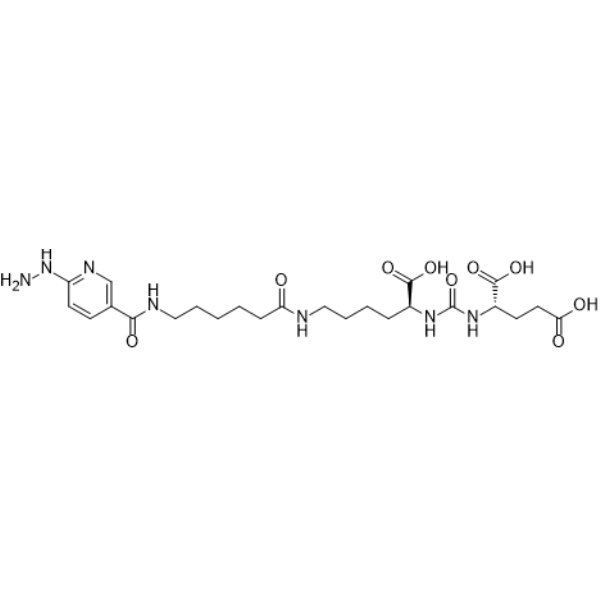
-
- HY-145769
-
|
|
PD-1/PD-L1
|
Cancer
|
|
N2S2-CBMBC, an N2S2 bromo-benzyl ether derivative, acts as a ligand and use 99mTc-labelled complexes 99mTc-N2S2-CBMBC can be used as an imaging agent to be applied to the aspect of detecting PD-L1 expression, realize the real-time, comprehensive and convenient detection of the PD-L1 level of tumors, and overcome the defects of an immunohistochemical method .
|
-
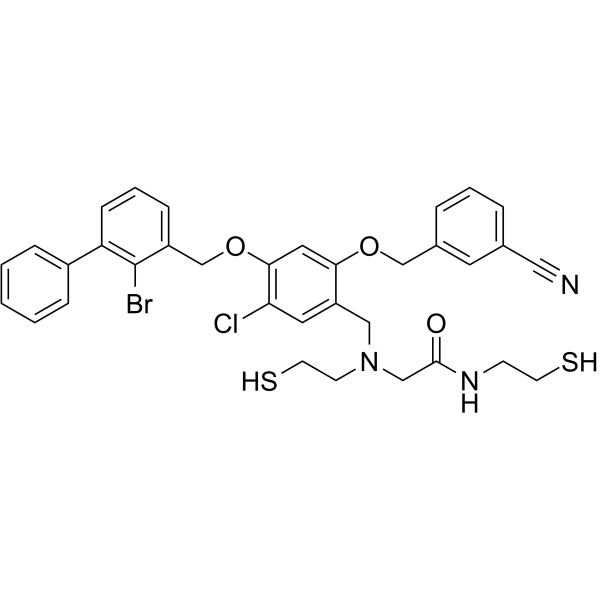
-
- HY-160066
-
|
|
Others
|
Cancer
|
|
SYL3C aptamer sodium is a DNA aptamer that targets the epithelial cell adhesion molecule (EpCAM) on the surface of cancer cells. SYL3C aptamer sodium targets multiple human cancer cell lines including MDA-MB-231, Kato III, HT-29, T47D and SW480. The Kd of SYL3C aptamer sodium against breast cancer cell line MDA-MB-231 and gastric cancer cell line Kato III is 38 nM and 67 nM, respectively. SYL3C aptamer sodium provides stability, high binding affinity, and selectivity for targeted cancer therapy, cancer cell imaging, and circulating tumor cell detection .
|
-

| Cat. No. |
Product Name |
Type |
-
- HY-D2285
-
|
|
Fluorescent Dyes/Probes
|
|
MOR-CES2 is a near-infrared fluorescent probe (Ex= 630 nm, Em=735 nm) capable of identifying cancer cells and tissues, as well as exhibiting a sensitive response to inflammation. MOR-CES2 holds potential as an efficient imaging tool in assisting surgical resection of CES2-related tumors .
|
-
- HY-150979
-
|
|
Fluorescent Dyes/Probes
|
|
Gd-NMC-3 is a near-infrared fluorescence/magnetic resonance (NIRF/MR) bimodal imaging probe. Gd-NMC-3 shows high resolution and sensitivity in tumor imaging with good biocompatibility, indicating huge application potential .
|
-
- HY-162051
-
|
|
Fluorescent Dyes/Probes
|
|
CYP1B1-IN-6 (compound 19) is a fluorescence molecular probes which inhibits CYP1B1 activity. CYP1B1-IN-6 can identify tumor sites in fluorescence imaging and photoacoustic imaging modes .
|
-
- HY-D2281
-
|
|
Dyes
|
|
[99m Tc]Tc-6-1, a 99mTc-labeled FAPI-46 derivative, is a specific fibroblast activation protein (FAP)-targeted radiotracer. [99m Tc]Tc-6-1 exhibits good tumor uptake and acts as a promising molecular tracer for FAP tumor imaging .
|
-
- HY-D2334
-
|
|
Dyes
|
|
AlF-NOTA-c-d-VAP is a peptide positron emission tomography (PET) probe that used for targeted tumor imaging of GRP78. AlF-NOTA-c-d-VAP demonstrates high stability in vitro and in vivo .
|
| Cat. No. |
Product Name |
Target |
Research Area |
-
- HY-P1043A
-
|
|
Aminopeptidase
|
Cancer
|
|
NGR peptide Trifluoroacetatecontaining the Asn-Gly-Arg (NGR) motif. NGR peptide Trifluoroacetate binds to APN/CD13. NGR peptide Trifluoroacetate is directly conjugated to imaging agents that can be used for tumor imaging .
|
-
- HY-P5128
-
|
Satoreotide tetraxetan
|
Somatostatin Receptor
|
Cancer
|
|
DOTA-JR11 is a somatostatin receptor 2 (SSTR2)antagonist. DOTA-JR11 can be labeled by 68Ga, used for paired imaging in neuroendocrine tumors (NETs) research .
|
-
- HY-P1043
-
|
|
Aminopeptidase
|
Cancer
|
|
NGR peptide containing the Asn-Gly-Arg (NGR) motif. NGR peptide binds to APN/CD13. NGR peptide is directly conjugated to imaging agents that can be used for tumor imaging .
|
-
- HY-114133
-
|
|
Peptides
|
Cancer
|
|
Depreotide is a nove tumor tarcer, can be complexed with technetium-99m ( 99mTc-depreotide) for optimal imaging properties. 99mTc-depreotide somatostain receptor imaging has been playing an important role in medical diagnosis research .
|
-
- HY-P5292
-
|
|
PSMA
|
Cancer
|
|
HYNIC-iPSMA is a ligand for molecular imaging of tumors. Hynic-ipsma consists of two components: HYNIC (6-hydrazinonicotinamide) and iPSMA (Inhibitor of Prostate-Specific Membrane Antigen). HYNIC is a compound used to attach radioactive isotopes to targeted molecules. iPSMA is a specific inhibitor used to inhibit prostate-specific membrane antigen (PSMA). 68GA-labeled iPSMA has been used to detect prostate cancer by PET imaging. The further 99mTc-EDDA/HYNIC-iPSMA has excellent specificity and sensitivity .
|
-
- HY-P5520
-
|
|
Bombesin Receptor
|
Cancer
|
|
GB-6 is a short linear peptide that targets the gastrin releasing peptide receptor (GRPR). GRPR is overexpressed in pancreatic cancer. Based on the tumor selectivity and tumor-specific accumulation properties of GB-6, GB-6 labeled with near infrared (NIR) fluorescent dyes or radionuclide netium-99m (99mTc) can be used as a high-contrast imaging probe. GB-6 has excellent in vivo stability, with tumor to pancreatic and intestinal fluorescence signal ratios of 5.2 and 6.3, respectively, in SW199 0 subcutaneous xenograft models. GB-6 can rapidly target tumors and accurately delineate tumor boundaries, which has broad application prospects .
|
-
- HY-P5018
-
|
|
Peptides
|
Cancer
|
|
NOTA-AE105 is an PET ligand of urokinase-type plasminogen activator receptor (uPAR), which can be radiolabeled by 64Cu and 68Ga. 68Ga-NOTA-AE105 and 64Cu-NOTA-AE105 shows high image contrast, resulting in clear tumor delineation .
|
-
- HY-P5290
-
|
|
PSMA
|
Cancer
|
|
HYNIC-PSMA is a ligand for molecular imaging of tumors. Hynic-psma consists of two components: HYNIC (6-hydrazinonicotinamide) and PSMA (Prostate-Specific Membrane Antigen). HYNIC is a compound used to attach radioactive isotopes to targeted molecules, such as 188Re-HYNIC-PSMA. PSMA is a membrane antigen that is specifically expressed on the surface of prostate cancer cells. HYNIC-PSMA can be used in prostate cancer research .
|
| Cat. No. |
Product Name |
Target |
Research Area |
-
- HY-P99289
-
|
Antibody hLL 2; Anti-Human CD22 Recombinant Antibody
|
CD22
|
Inflammation/Immunology
Cancer
|
|
Epratuzumab (Antibody hLL 2) is an anti-CD22 IgG1 monoclonal antibody. Epratuzumab is also a tumor-imaging agent and an immunomodulatory agent. Epratuzumab can induce CD22 phosphorylation. Epratuzumab has been used to research non-Hodgkin’s lymphomas (NHL) and certain autoimmune diseases .
|
| Cat. No. |
Product Name |
Category |
Target |
Chemical Structure |
Your information is safe with us. * Required Fields.
Inquiry Information
- Product Name:
- Cat. No.:
- Quantity:
- MCE Japan Authorized Agent:




























![[99mTc]Tc-6–1](http://file.medchemexpress.com/product_pic/hy-d2281.gif)






















